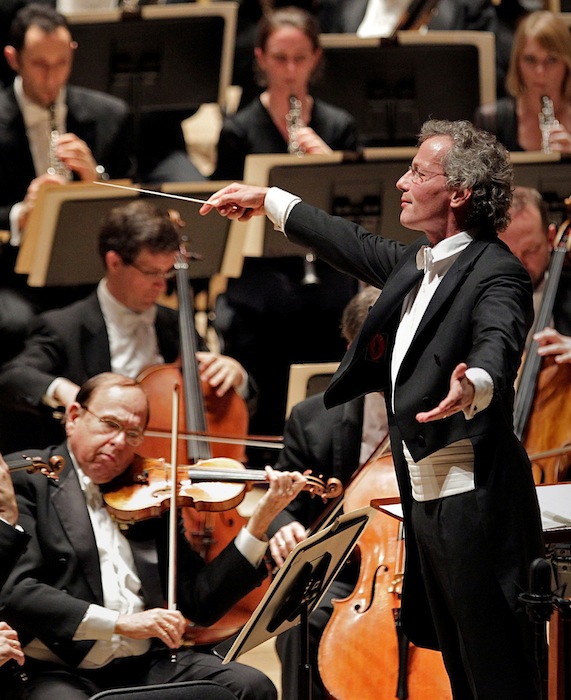Cleveland Orchestra closes Miami season with Beethoven of clarity and power

Franz Welser-Möst conducted the Cleveland Orchestra in music of Beethoven Saturday night at the Arsht Center in Miami.
At its best, an all-Beethoven orchestral concert should promise an evening of symphonic thunder, with sweeping crescendos and hard-driving fortissimo passages.
The Cleveland Orchestra’s final concert of the season in Miami delivered all that. Yet the orchestra under music director Franz Welser-Möst took a faster, lighter approach to three Beethoven works.
Rather than relying on the sheer weight and power of one of the world’s great orchestras, he emphasized a strong sense of forward momentum, transparent textures and carefully calibrated levels of intensity to express the force of Beethoven’s musical ideas.
Saturday night’s concert at the Arsht Center opened with the Coriolan Overture, a classic example of Beethoven in heroic mode, with a grim tone and gruff, clipped motifs. Under Welser-Möst’s baton, the orchestra took a fleeter, less obviously portentous approach than many interpretations, expressing the work’s energy through propulsive force rather than volume. Aiding in drawing out the work’s power were the orchestra’s rich tone and crisp attacks, with Welser-Möst leading a muscular crescendo toward the end, before the music faded away.
Orchestral virtuosity extends beyond the flashy works of Strauss, Tchaikovsky and other masters of instrumentation. In the Cleveland Orchestra’s performance of Beethoven’s Symphony No. 8, virtuosity appeared in the unity and warm tone of the strings in the opening Allegro vivace, in the elegant phrasing and immaculate playing of horns and clarinet in the third movement trio, in the richness, clarity and balance of the last movement’s cheerful theme, showing Beethoven at his most jovial.
Beethoven saved his lighter orchestral thoughts for his even-numbered symphonies, and of his mature works in the form, the Eighth Symphony is the lightest. But under Welser-Möst, the orchestra played with such dynamic and interpretative range that the performance carried unusual subtlety and depth. In the mysterious minor-key passages that occur in the opening Allegro vivace, for example, he brought the orchestra to a pianissimo that carried through the hall, brooding and tense, before opening it up for a full-volume statement of the sturdy second theme.
The performance of Beethoven’s Fifth Symphony showed a similar interpretive approach to that of the Coriolan Overture, in its reliance more on momentum than brute force.
Welser-Möst took the opening Allegro con brio at a brisk tempo. The contrast to conventional interpretations was particularly apparent here, where many conductors hammer away at the famous four-note opening motif in a manner that grows slower and more monumental with each repetition. Welser-Möst didn’t slow down at all, relying on percussive force and rhythmic vigor to realize the force of the music.
The movement almost seemed to be subtly speeding up, such was the drive of the playing, with the sinuous soft interludes coming off with particularly ominous power. After the oboe cadenza late in the movement, Welser-Möst drove a crescendo of ferocious energy that brought the movement to an end. Although audience members had rigidly obeyed the rule against applauding between movements in the Eighth Symphony, several listeners apparently couldn’t help themselves at the conclusion of this movement, a testament to the compelling nature of this performance.
In the Andante, brass, winds and strings produced a burnished, glowing tone. Brass instruments made their weight felt in the muscular statements of the theme and its climactic restatement toward the end, without disturbing the rich, balanced texture of the orchestra. Violas played with uncommonly graceful phrasing in the quick notes of one variation. Welser-Möst again brought the orchestra to extreme pianissimos that never lost clarity, an expansion of the orchestra’s dynamic range that gave the movement a sense of arching grandeur.
One of the most anticipated moments in this symphony is the transition from the Scherzo to the Finale, where mysterious, primordial tones grow into a shining, major-key affirmation that resolves the darkness and drama that began with the first movement.
The orchestra’s performance did this passage full justice, with barely audible tones in the violins suddenly rising to a full-force statement of the opening theme. Here, Welser-Möst took a weightier approach than before. But the transparency and clarity of the orchestra allowed all sections to be heard without any loss of the main ideas of each passage–an aural equivalent to the burst of sunshine expressed by the music.
Posted in Performances
One Response to “Cleveland Orchestra closes Miami season with Beethoven of clarity and power”
Leave a Comment
Sun Feb 4, 2018
at 10:37 am
1 Comment





Posted Feb 04, 2018 at 8:25 pm by Enrique Sanchez
YES! The concert was all that and more! Very memorable night of Beethoven!